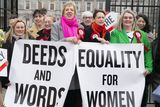Labour market participation at highest level since before 2008 crash
There are now a record 2,655,900 people in employment in Ireland, the Central Statistics Office said in its Labour Force Survey
There are a record number of people in work in Ireland, with the participation rate the highest it has been since 2008. Photo: Getty
The share of the total population in work was 65.8pc in the three months to September, the highest it has been since just before the 2008 financial crash.
There are now a record 2,655,900 people in employment in Ireland, the Central Statistics Office said in its Labour Force Survey today.
That is an increase of 101,600 or 4pc in the year to September, with the increase for females rising at twice the rate of males. The increase was larger for people in part-time employment than for those in full-time employment.
It amounts to an employment rate — the share of the working age population in work — of 74.1pc in the third quarter, up slightly on last year.
The employment rate for males was 78.4pc, compared to 70pc for females.
The employment rate was lowest among those aged 15-19 years and highest among those aged 35-44 years.
There was an increase in people employed in all sectors compared to the third quarter last year, except construction and industry. However, the numbers employed in construction was up by 14pc compared to the third quarter of 2021.
The numbers employed in the information and communications sector increased by almost 11pc compared to the third quarter last year, despite a global tech jobs slowdown.
The healthcare, wholesale and retail and industry sectors employ the most people in the country.
However, there has been a slight increase in the unemployment rate compared to last year, to 4.6pc, from 4.5pc in the third quarter of 2022.
Youth unemployment (for those age 15-24) was running at 12.2pc in the third quarter, up slightly from 12pc in the same period last year.
The unemployment rate for men has risen to 4.7pc from 4.2pc a year earlier, while the corresponding rates for females fell to 4.6pc from 4.8pc last year.
The estimated total number of hours worked per week in the third quarter increased by 1.7 million hours or 2.1pc on the same period last year, to 82.0 million hours.
Of the more than 2.6 million people in employment, 262,300 or 9.9pc were absent from work during a reference week, for things like holidays, sick leave or maternity leave, down slightly on the same period last year.
The biggest absence rate was in the education sector, at 30pc, though this is down on the previous two years.
Absences were up in the construction sector but down significantly in agriculture and tech.
Total hours worked was highest in the industry and health sectors.













.jpg)

